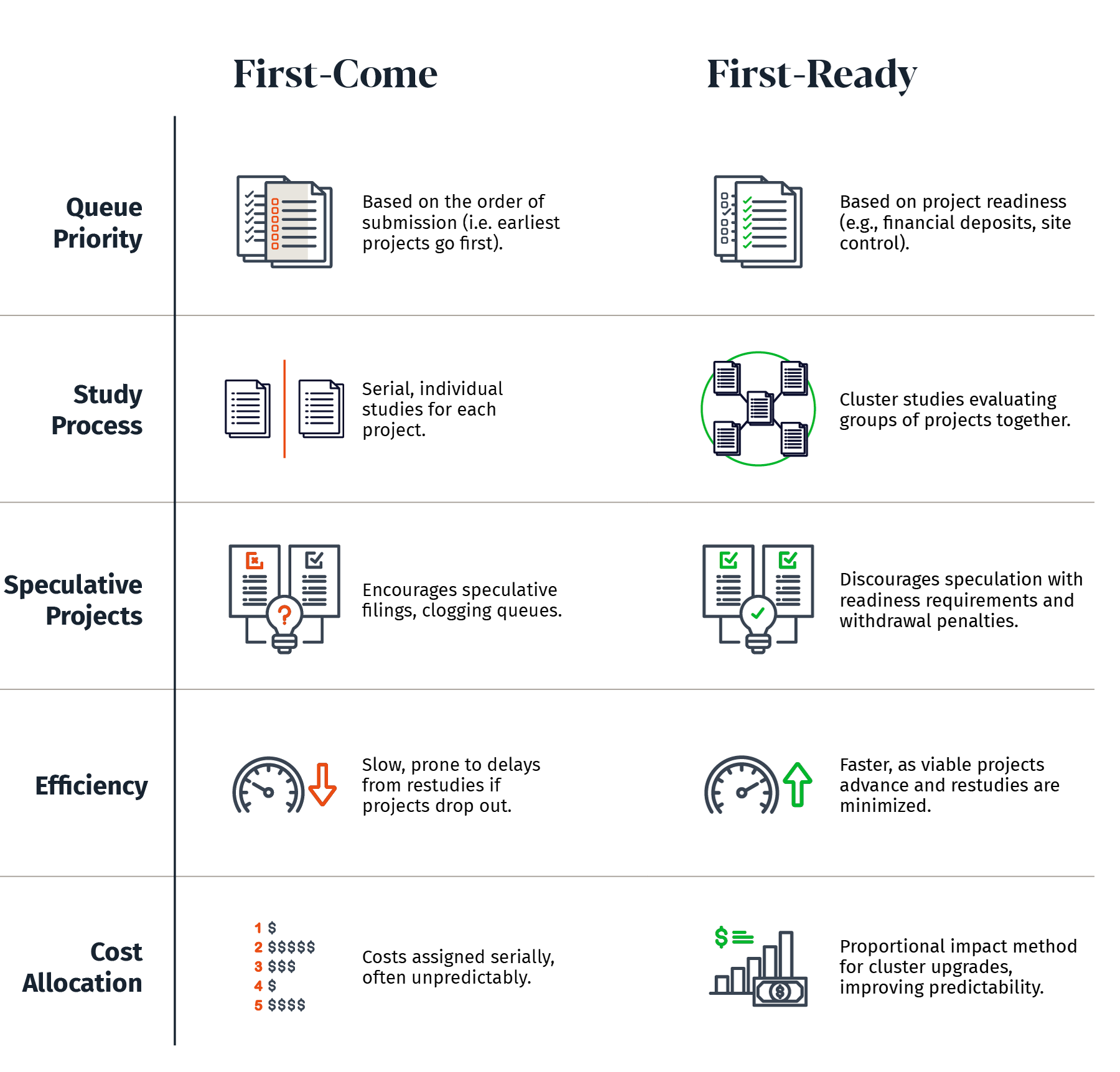
The energy landscape in the United States is undergoing a seismic shift, driven by the rapid integration of renewable energy resources and the urgent need to modernize our aging electric grid. At the heart of this transformation is the Federal Energy Regulatory Commission’s (FERC) Order 2023, a landmark ruling issued on July 28, 2023, aimed at streamlining the generation interconnection process. This blog post dives into what FERC Order 2023 entails, how it relates to hosting capacity studies and tools, the current state of these tools, and how they should adapt to comply with the order.
FERC Order 2023: The Grid’s New Rulebook
FERC Order 2023 is a comprehensive reform of the generator interconnection procedures and agreements that govern how new generating facilities connect to the electric grid. The order addresses long-standing issues like interconnection queue backlogs, cost uncertainty, and delays that have plagued the process, especially as renewable energy projects have surged. Key reforms include:
- Shift to a Cluster Study Process: Moving from individual, serial studies to batch or “cluster” studies of multiple projects.
- First-Ready, First-Served Approach: Prioritizing projects that demonstrate commercial readiness over those that simply enter the queue first.
- Stricter Deadlines and Penalties: Imposing firm study deadlines on transmission providers, with penalties for delays.
- Enhanced Transparency: Requiring tools like transmission capacity “heatmaps” to provide interconnection customers with better information.
- Grid Enhancing Technologies (GET): Incorporating advancements like alternative transmission technologies and co-located resource flexibility into the process.
These changes aim to make interconnection more efficient, reliable, and equitable, ensuring that viable projects can connect to the grid faster.
Find out what Simple Thread is doing to streamline the generation interconnection process:
First-Come vs. First-Ready: The Race to the Grid
The transition from “first-come, first-served” (FCFS) to “first-ready, first-served” (FRFS) is a cornerstone of FERC Order 2023. Here’s how they compare:

FCFS rewarded early filers, even if their projects weren’t viable, leading to a backlog of over 1,400 gigawatts of generation waiting in queues by 2021. FRFS, by contrast, prioritizes projects that are shovel-ready, reducing queue clutter and speeding up connections for serious developers. While FCFS was simpler in theory, it was designed for an era when a small number of large generators were requesting to interconnect to the grid. However, FRFS better aligns with today’s complex, renewable-heavy energy mix, where the interconnection requests have shifted to large number of smaller generators.
How FERC Order 2023 Relates to Hosting Capacity Studies and Tools
Hosting capacity studies assess how much additional generation a transmission or distribution system can accommodate without requiring significant upgrades. These studies are critical for interconnection because they determine the grid’s ability to “host” new projects without compromising reliability or incurring excessive costs.
FERC Order 2023 directly ties into hosting capacity by emphasizing the need for better data and tools to inform interconnection decisions. The order mandates that transmission providers develop and share heatmaps (visual representations of available transmission capacity) based on recent cluster studies. These heatmaps (e.g. MISO’s POI map) are essentially hosting capacity tools at the transmission level, offering interconnection customers a clearer picture of where capacity exists and where upgrades might be needed. By requiring this transparency, FERC Order 2023 ensures that hosting capacity analysis becomes a proactive part of the interconnection process, rather than a reactive afterthought.
Moreover, the shift to cluster studies aligns hosting capacity with a broader, system-wide perspective. Instead of assessing capacity for each project individually, transmission providers must now evaluate groups of projects simultaneously, necessitating more robust hosting capacity tools that can handle complex, multi-project scenarios.

Minerva was designed to streamline and automate power grid interconnection studies to address current needs. Learn more →
Are Hosting Capacity Tools Ready for Prime Time?
At the transmission level, hosting capacity tools are not standardized. Many transmission providers rely on internal studies or proprietary software, with results often opaque to developers. Tools like those used by regional transmission organizations (RTOs) such as PJM or MISO vary in sophistication, ranging from basic capacity estimates to detailed simulations incorporating real-time data. The lack of uniformity and accessibility has been a bottleneck, contributing to the interconnection queue delays that FERC Order 2023 seeks to address.
Current tools also struggle with integrating emerging technologies (e.g., energy storage) and alternative transmission solutions (e.g., dynamic line ratings). Existing tools were designed for a more simple and static grid, the dynamic, data-intensive, and system-wide impacts that these technologies have pose real challenges. For example, traditional grid models are built around predictable, dispatchable generation and passive loads. Energy storage introduces bidirectional power flows and operational flexibility that challenge these models. Additionally, battery storages are unique because they can act as both a load (when charging) and a generator (when discharging). This dual behavior introduces complexity that many current tools are not designed to handle. Traditional tools often model grid components as either generation or load, not both, and struggle to simulate the dynamic, time-dependent operation of storage systems. Lastly, the regulatory framework for energy storage is still evolving, and there’s a lack of standardized methods for modeling storage in interconnection studies.
While some utilities and RTOs have begun adopting advanced software for dynamic hosting capacity analysis, adoption is uneven, and many still use static models that don’t fully reflect grid conditions or future upgrades.
Adapting Hosting Capacity to Abide by FERC Order 2023
To comply with FERC Order 2023, hosting capacity tools and studies must evolve in several key ways:
- Integration with Cluster Studies: Tools must shift from single-project assessments to analyzing clusters of interconnection requests. This requires enhanced modeling capabilities to evaluate cumulative impacts on transmission capacity, including network upgrades triggered by multiple projects.
- Heatmap Development: Transmission providers must develop publicly accessible heatmaps based on power flow models from recent cluster studies. These should include in-service and higher-queued upgrades, using both Network Resource Interconnection Service (NRIS) and Energy Resource Interconnection Service (ERIS) assumptions to provide a comprehensive view of capacity.
- Real-Time and Dynamic Analysis: Static hosting capacity models won’t suffice. Tools should incorporate real-time data and dynamic simulations to reflect changing grid conditions, such as load patterns or renewable generation variability.
- Incorporation of GETs: Order 2023 mandates evaluating alternative transmission technologies (e.g., advanced power flow control devices, synchronous condensers, dynamic line ratings). Hosting capacity tools must be adapted to assess how these technologies expand capacity, offering faster and cheaper alternatives to traditional upgrades.
- Transparency and Accessibility: Tools must be user-friendly and publicly available, aligning with the order’s emphasis on reducing information asymmetry between transmission providers and interconnection customers.
By adapting hosting capacity studies in these ways, transmission providers can better support the “first-ready, first-served” process, ensuring that viable projects move forward efficiently while speculative ones are filtered out. Given the rapid shift and growing need and limited capabilities of existing tools, the partnership between software development companies and transmission providers is crucial to ensure rapid advancement.
How FERC Order 2023 Impacts the Grid
While FERC Order 2023’s primary focus is transmission level interconnection, for distribution systems, the impact is indirect but significant. Many DERs (e.g., rooftop solar, small battery storage) interconnect at the distribution level before aggregating to transmission. Order 2023’s reforms to small generator interconnection procedures (SGIP) mirror those for large generators, promoting consistency. Enhanced hosting capacity tools at the transmission level could trickle down, encouraging utilities to align distribution-level analyses with transmission planning, especially as inverter based resources (IBRs) increasingly influence bulk power systems and large loads (e.g. data centers) are looking to interconnect whatever capacity is readily available.
Overall, the order fosters a more integrated approach, bridging the transmission-distribution divide and supporting a grid that can handle a higher penetration of renewables, and increased generation to meet the rapid load growth due to electrification efforts and large load interconnection requests (e.g. data centers) due to AI trends.
Incorporating GETs into the Interconnection Process
FERC Order 2023 recognizes that technological advancements are key to modernizing interconnection. Here’s how it integrates them:
- Co-Location Flexibility: Transmission providers must allow multiple resources (e.g., solar + storage) to co-locate behind a single point of interconnection and share one request. This supports hybrid projects, reducing study complexity and grid impact.
- Alternative Transmission Technologies: Providers must evaluate options like advanced conductors, power flow control devices, and voltage source converters in cluster studies. These can boost capacity quickly and cost-effectively compared to traditional upgrades, with providers retaining discretion on implementation.
- Storage Operating Assumptions: Studies must reflect the proposed charging behavior of electric storage resources, ensuring accurate modeling of their grid interactions (e.g., not treating charging as firm load unless specified).
- Non-Synchronous Resource Requirements: For wind, solar, and other inverter-based resources, the order mandates validated models and “ride-through” capabilities (maintaining operation during disturbances), enhancing grid reliability as these technologies proliferate.
These reforms ensure the interconnection process keeps pace with innovations, facilitating the integration of renewables and storage while maintaining system stability.
Final Thoughts
FERC Order 2023 represents a pivotal shift in how energy resources are integrated into the grid. By improving interconnection processes, promoting transparency, and leveraging hosting capacity tools more effectively, this order will help accelerate the clean energy transition. However, to fully realize its benefits, utilities and stakeholders must invest in enhancing hosting capacity studies and ensuring they are aligned with the evolving regulatory landscape. By doing so, the industry can achieve a more efficient, reliable, and resilient power system for the future.
Loved the article? Hated it? Didn’t even read it?
We’d love to hear from you.




